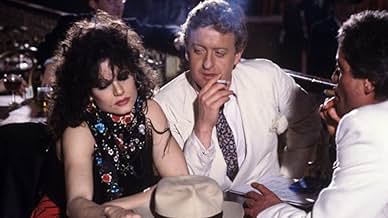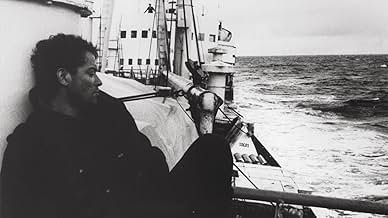IMDb RATING
7.1/10
1.2K
YOUR RATING
A drunken sailor recounts the surrealistic odyssey of his life story to a murderous student.A drunken sailor recounts the surrealistic odyssey of his life story to a murderous student.A drunken sailor recounts the surrealistic odyssey of his life story to a murderous student.
- Awards
- 1 win & 2 nominations
Paula Brunet-Sancho
- Moroccan streetwalker
- (as Pauline Brunet)
Mostefa Djadjam
- Ahmed
- (as Mostepha Djadjam)
Wladimir Ivanovsky
- The Impersonator
- (as Vladimir Ivanovsky)
Adelaide João
- The sailor's mother
- (as Adélaïde Joao)
- Director
- Writers
- All cast & crew
- Production, box office & more at IMDbPro
Storyline
Did you know
- TriviaRuiz's screenplay was partially inspired by the Chilean myth of the Caleuche ghost ship.
- Quotes
L'étudiant: On the night of July 25, 1958 I killed Ladislaw Zukarevitch, antique dealer, my mentor, my master in the art of polishing diamonds, my tutor at Warsaw Theological School. I got nothing out of this crime except the ring he offered me many times; several hundred marks; a collection of old coins, of no value; and a long letter where he advised me to leave the country.
- ConnectionsEdited into Catalogue of Ships (2008)
Featured review
So my ongoing project is to seek out films that point towards a true perception, a way of seeing things as they are and why. If the image has power as a fragment of the consciousness it informs and is informed by, then in entering a film we literally see what another has seen or dreamed, imprinted with what he means by seeing whatever it is he sees.
If this kind of film is rarely encountered, it's precisely because so many filmmakers see things in order to mean something else. Rarely do they mean what they see.
Some of my most cherished filmmakers dismantle with clarity of vision the cluttered notions, ideas, meanings, we associate with those images so that only the image remains, along with what echoes it has stirred in us. This is akin to meditation for me, a process of emptying out.
Another group of films I am drawn to use the opposite means, but look for the same. These assail our established notions (that things make sense a certain way) by fabricating other notions to confound or challenge that sense, by precisely cluttering their apparent order with various synthetic modes, symmetries or layered patterns. The idea here is that by losing ourselves in these stratagems, we awake to the activity of the mind that obscures the true picture. We look at things as through a kaleidoscope, not simply to enjoy the phantasmagoria, but so that we may become aware of that kaleidoscope that fractures the seeing.
This one belongs in this company, next to Greenaway and Welles.
So what we have here is another cunning web of stories within others, narrators within their selves projected into these stories. A sailor is recounting a story of sailing the High Seas to a young student, like in something Herman Melville might have written 150 years ago, or R.L. Stevenson.
We stop at various ports in this voyage, where fragments of life are recounted as vignettes. Various commentaries can be found in these, each one an elaborate ploy that informs others in turn.
In Singapore for example, the sailor meets with a local kid and the French proconsul. The proconsul translates what the kid says, but is he really? He says the kid is actually a wise old man, and that he must be kept from eating so that he won't grow old. In starving the kid, he posits that he's doing him a favour. The colonial commentary should be obvious, which Ruiz probably felt like he had inherited by working in France.
In Dakar he's met with a black doctor, who asks money and tells him how the present moment is impregnated with all the other moments, past or yet to come. Elsewhere he is saved by a kid who claims that he is free to roam the territory of his parents yet, in not having discovered any borders to it, is strangely prisoner of that freedom. The kid points to books of Stevenson claiming he already knows the stories, and wants to live in the world, not the page.
These fragments together comprise a kind of memoir, a mistress, wife, a kid. But again, how much of it true outside of the words? How much of it only a story the sailor picked up elsewhere and improvised some of his past upon it? We literally flow through these, like Welles would have the imagery; fluid motion, solid forms. Soaking up half-remembered atmospheres as thrown up by the imaginative mind. The mind which endlessly remembers, yearns, dreams, loathes, loves, talks with itself.
It's a rather beautiful construct overall; a ship as vessel of the imagination sailing on inscrutable seas, where all the sailors aboard are dead (like memories, to be conveniently arranged) except one, with the ability to dream ship and voyage. Who comes back with stories from that voyage, stories that involve parts of himself real or imagined.
This may had been an astonishing work if what reality anchored the imaginative flight could resonate inside the fantasy. On the level of reality there is the sailor narrating to the student; they are in a kind of ballroom and around them dance various couples. I wonder, will this mean to you what it does to me?
If this kind of film is rarely encountered, it's precisely because so many filmmakers see things in order to mean something else. Rarely do they mean what they see.
Some of my most cherished filmmakers dismantle with clarity of vision the cluttered notions, ideas, meanings, we associate with those images so that only the image remains, along with what echoes it has stirred in us. This is akin to meditation for me, a process of emptying out.
Another group of films I am drawn to use the opposite means, but look for the same. These assail our established notions (that things make sense a certain way) by fabricating other notions to confound or challenge that sense, by precisely cluttering their apparent order with various synthetic modes, symmetries or layered patterns. The idea here is that by losing ourselves in these stratagems, we awake to the activity of the mind that obscures the true picture. We look at things as through a kaleidoscope, not simply to enjoy the phantasmagoria, but so that we may become aware of that kaleidoscope that fractures the seeing.
This one belongs in this company, next to Greenaway and Welles.
So what we have here is another cunning web of stories within others, narrators within their selves projected into these stories. A sailor is recounting a story of sailing the High Seas to a young student, like in something Herman Melville might have written 150 years ago, or R.L. Stevenson.
We stop at various ports in this voyage, where fragments of life are recounted as vignettes. Various commentaries can be found in these, each one an elaborate ploy that informs others in turn.
In Singapore for example, the sailor meets with a local kid and the French proconsul. The proconsul translates what the kid says, but is he really? He says the kid is actually a wise old man, and that he must be kept from eating so that he won't grow old. In starving the kid, he posits that he's doing him a favour. The colonial commentary should be obvious, which Ruiz probably felt like he had inherited by working in France.
In Dakar he's met with a black doctor, who asks money and tells him how the present moment is impregnated with all the other moments, past or yet to come. Elsewhere he is saved by a kid who claims that he is free to roam the territory of his parents yet, in not having discovered any borders to it, is strangely prisoner of that freedom. The kid points to books of Stevenson claiming he already knows the stories, and wants to live in the world, not the page.
These fragments together comprise a kind of memoir, a mistress, wife, a kid. But again, how much of it true outside of the words? How much of it only a story the sailor picked up elsewhere and improvised some of his past upon it? We literally flow through these, like Welles would have the imagery; fluid motion, solid forms. Soaking up half-remembered atmospheres as thrown up by the imaginative mind. The mind which endlessly remembers, yearns, dreams, loathes, loves, talks with itself.
It's a rather beautiful construct overall; a ship as vessel of the imagination sailing on inscrutable seas, where all the sailors aboard are dead (like memories, to be conveniently arranged) except one, with the ability to dream ship and voyage. Who comes back with stories from that voyage, stories that involve parts of himself real or imagined.
This may had been an astonishing work if what reality anchored the imaginative flight could resonate inside the fantasy. On the level of reality there is the sailor narrating to the student; they are in a kind of ballroom and around them dance various couples. I wonder, will this mean to you what it does to me?
- chaos-rampant
- Jun 8, 2011
- Permalink
- How long is Three Crowns of the Sailor?Powered by Alexa
Details
- Runtime1 hour 57 minutes
- Sound mix
- Aspect ratio
- 1.33 : 1
Contribute to this page
Suggest an edit or add missing content























